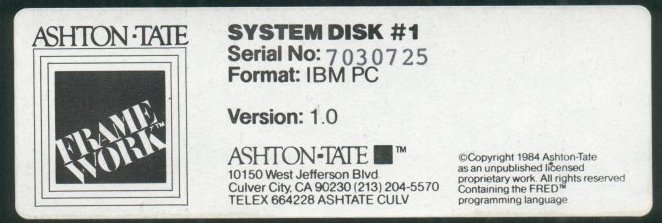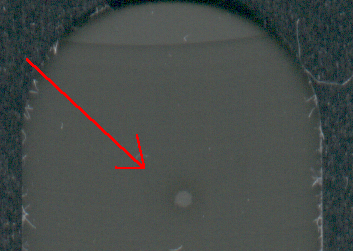Software Spotlight - Ashton Tate Framework 1.0
It feels kind of odd spotlighting a program I haven't gotten to run yet, but I want to draw attention to Ashton-Tate Framework 1.0. The Framework office suite is historically notable as the first all-in-one office suite for IBM PC compatible computers. It was originally created by Forefront Corporation for Ashton-Tate and first released in 1984. It has a built in word processor, spreadsheet, database, outliner, graphing, and telecommunications. Framework provides a text-based "gui", including windowing and menus and all of the different components behave in similar, consistent ways.
Download library page here:
https://winworldpc.com/product/framework/10

But more relevant to this specific version, it is copy protected using laser-holes/damaged area. What that means is that even a Kryoflux or SuperCard Pro can not copy it!
I have not tried running it from the original disks yet, because I am not too keen on letting it write back to the originals.
Since I am running short on time right now, I will let the fine folks here have at it and see what they can come up with.

The master and master backup both have a small circular "bad spot" over the innermost track on the first (bottom) side. Plotted graphically, this bad area can be "seen" in the stream dump as an area of noise.
The bad spots on the master and backup are at slightly different locations relative to the index. This means it could know the difference between the two. The executables on each disk are encrypted, and the executables are different on each disk.
It could be that each executable has been "calibrated" specifically for every disk. There was some recent discussion on the Kryoflux form about another title that might do something like that. In that case, just making the sector "bad" would not be good enough. It would have to be "bad" at exactly certain byte locations. In that case the software would read the bad sector and compare what it wrote for known good bytes.
I did try writing a disk and placing a scratch over that sector. It came out looking similar on a Kryoflux dump, but the software still stuck its nose up at it.
The software requires that the original disk be in the drive and not write protected when the program is run, even if the program files are copied to a hard drive. A flyer included in 1.0 suggest that the next version (1.1?) would still be copy protected but permit hard drive installs without a keydisk.
On top of that, these disks look rather low quality. I have a hard time imagining they would have lasted long even when new.
Not sure about Framework II since we don't have that, but Framework III is not copy protected.
Off the top of my head, I am not aware that the PCE emulator can simulate bad sectors. Perhaps someone else can find a trick that would make it work.
Copy II PC NoGuard claims to support Framework, but it did not seem to work with these disks. I suspect its support is actually for Framework 1.1, not 1.0. That will not duplicate the disk, but would serve as an uprotect to make it run.
So, what do you folks think?
Download library page here:
https://winworldpc.com/product/framework/10

But more relevant to this specific version, it is copy protected using laser-holes/damaged area. What that means is that even a Kryoflux or SuperCard Pro can not copy it!
I have not tried running it from the original disks yet, because I am not too keen on letting it write back to the originals.
Since I am running short on time right now, I will let the fine folks here have at it and see what they can come up with.

The master and master backup both have a small circular "bad spot" over the innermost track on the first (bottom) side. Plotted graphically, this bad area can be "seen" in the stream dump as an area of noise.
The bad spots on the master and backup are at slightly different locations relative to the index. This means it could know the difference between the two. The executables on each disk are encrypted, and the executables are different on each disk.
It could be that each executable has been "calibrated" specifically for every disk. There was some recent discussion on the Kryoflux form about another title that might do something like that. In that case, just making the sector "bad" would not be good enough. It would have to be "bad" at exactly certain byte locations. In that case the software would read the bad sector and compare what it wrote for known good bytes.
I did try writing a disk and placing a scratch over that sector. It came out looking similar on a Kryoflux dump, but the software still stuck its nose up at it.
The software requires that the original disk be in the drive and not write protected when the program is run, even if the program files are copied to a hard drive. A flyer included in 1.0 suggest that the next version (1.1?) would still be copy protected but permit hard drive installs without a keydisk.
On top of that, these disks look rather low quality. I have a hard time imagining they would have lasted long even when new.
Not sure about Framework II since we don't have that, but Framework III is not copy protected.
Off the top of my head, I am not aware that the PCE emulator can simulate bad sectors. Perhaps someone else can find a trick that would make it work.
Copy II PC NoGuard claims to support Framework, but it did not seem to work with these disks. I suspect its support is actually for Framework 1.1, not 1.0. That will not duplicate the disk, but would serve as an uprotect to make it run.
So, what do you folks think?

Comments
Yes it can't be copied by KF/SCP/TC too.
(The Enhanced Option Board was needed. But this was very expensive than Deluxe Option Board or Trans Copy Board.)
PCE still doesn't support these copy protection.
Convert the Kryoflux stream files to .TC format using "flux2tc --consolidate track00.0.raw disk1.tc", and the same for disk 2. Mount the resulting image files in DOSBox-TC (using the default machine= type, not machine=cga) using "imgmount a disk1.tc disk2.tc -t floppy", making sure that the .TC image files are not write-protected and that "core" is set to anything other than "dynamic", then run "A:" and then "FW", pressing CTRL+F4 at the license screen to insert disk #2 before pressing ENTER to advance.
There is something weird going on at the license screen that may prevent the program from working on an AT. Basically, the program seems to expect the word at 0013:0002 to be zero, which is the case when using a PC or XT BIOS, but not when using an AT BIOS.
(This is the second laser-hole-protected disk that I have encountered. The other was a Chinese cheating utility named "Game Buster" which adorably prints "FUCK YOU ! THIS IS NOT THE ORIGINAL DISK ! YOU HAVE COPIED THE PROGRAM!" if the keydisk check fails, which of course does not happen with the current DOSBox-TC.
Now we have a working emulator for Laser Hole protection.
Thank you very much, NewRisingSun.
Here are a few quick screen shots:
Splash screen, Framework 1.00.
It even runs graphically in CGA mode.
At a glance anyway, the editor seems to support displaying bold and italic formatting, but not different font sizes. Similar to Word for DOS.
It is an all-in-one program that includes word processor, spread sheet, database, graphs, telecommunications and even a programming language.
Built in help too. The desktop seems quite a bit influenced by the Mac.
The message at exiting. Back up your disks? Riiiiiigh.
Also, exiting seems to crash the emulator?
In other words, Prolok's terminate program handler relies on a rare undocumented quirk of MS-DOS, which is why DOSBox' emulated DOS did not handle that correctly. I have uploaded a new version that does handle it correctly. But you can always boot real DOS and run Framework from there (type "boot dos20.ima disk1.tc disk2.tc", then press CTRL+F4 to switch to Framework disk #1 after DOS has finished booting).
Sorry, It is impossible to show the method without agreement of author of PCE.)
(I received it by Private Email and this is not public.)
I recommend to contact to author of PCE if you want.
This program works on PCE now, but it is impossible to use normal converted image from KF or SCP.
(It needs to fix the image manually.)
I recommend to use DOSBOX-TC if you want to run it without fix.
Also, I thought that PCE was released under the GNU Public License, which would mean that any changes made to it would also be released under the same license, and would likewise be freely redistributable as a result.
Normally I would contact him, though since people right now seem to be ignoring me, if it's someone who accomplished anything like that and since I'm largely an outsider here, I just naturally assume that they would ignore me completely for that reason (because I'm not on their "contacts" list).
But since you're apparently a close contact with him, then it would be greatly appreciated if you could ask him whether he would be interested in contacting me about it. I could even send you my email address if you want to send it to him, so that he could contact me privately from there. At least then he would be far more likely to respond to my requests, since he would know that I actually had a legitimate use for this feature.
Anyway, I can't share the converted image.
But you can download it new PCE version.
http://www.hampa.ch/pub/pce/pre/pce-201 ... -win32.zip
P.S. Please do Not quote whole sentence to me in the next time.
(Whole quote irritated me.)
Also, sorry about the long quote - I only posted it that way so that you would easily see which post that you were responding to. I'll try to keep down the quote size next time.
There is no secret. Hampa changed PSI format. He added chunk "WEAK" to PSI format and modified related source code.
>There is no secret. Hampa changed PSI format. He added chunk "WEAK" to PSI format and >modified related source code.
Well, you really don't know the secret exactly.
That is Not related with secret.
I've made several Kryoflux dumps of copy-protected games. I've managed to convert several of them into Transcopy images to run in DOSBox-TC, but two of them are giving me problems. When using the PCE tools, the images do not work and the file sizes seem smaller than they should be. When I use flux2tc, it just crashes as soon as it starts the conversion. I was wondering if someone could help. I'm not sure what the forum rules are regarding posting the stream files. I can PM a link to Dropbox if that would be more appropriate. Thanks.